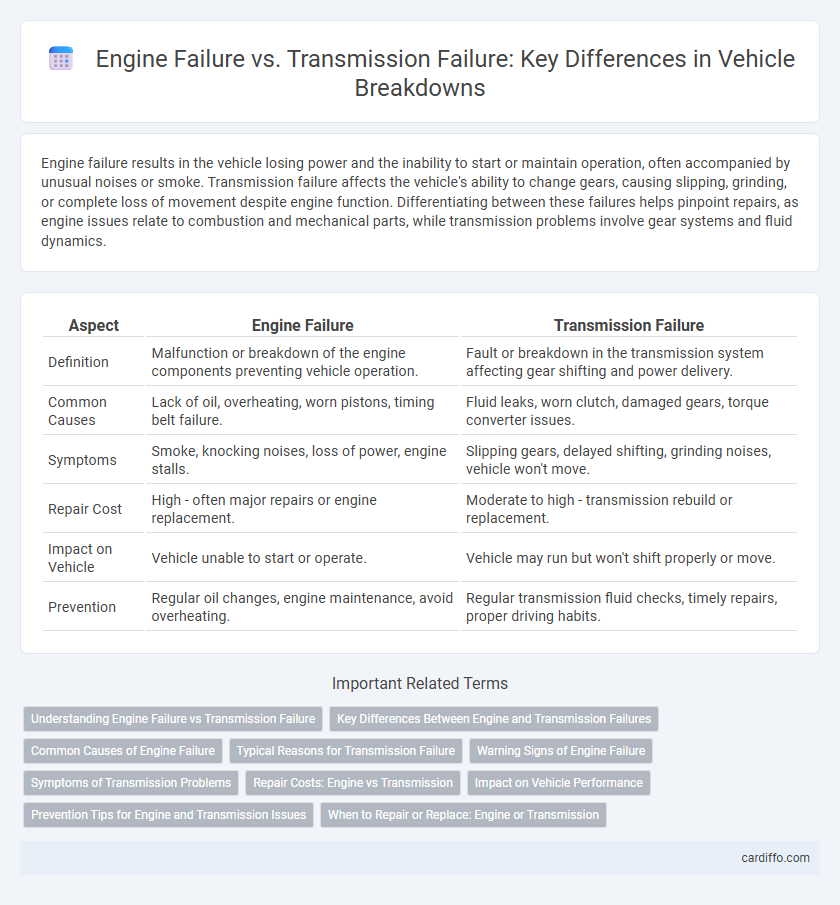Engine failure results in the vehicle losing power and the inability to start or maintain operation, often accompanied by unusual noises or smoke. Transmission failure affects the vehicle's ability to change gears, causing slipping, grinding, or complete loss of movement despite engine function. Differentiating between these failures helps pinpoint repairs, as engine issues relate to combustion and mechanical parts, while transmission problems involve gear systems and fluid dynamics.
Table of Comparison
| Aspect | Engine Failure | Transmission Failure |
|---|---|---|
| Definition | Malfunction or breakdown of the engine components preventing vehicle operation. | Fault or breakdown in the transmission system affecting gear shifting and power delivery. |
| Common Causes | Lack of oil, overheating, worn pistons, timing belt failure. | Fluid leaks, worn clutch, damaged gears, torque converter issues. |
| Symptoms | Smoke, knocking noises, loss of power, engine stalls. | Slipping gears, delayed shifting, grinding noises, vehicle won't move. |
| Repair Cost | High - often major repairs or engine replacement. | Moderate to high - transmission rebuild or replacement. |
| Impact on Vehicle | Vehicle unable to start or operate. | Vehicle may run but won't shift properly or move. |
| Prevention | Regular oil changes, engine maintenance, avoid overheating. | Regular transmission fluid checks, timely repairs, proper driving habits. |
Understanding Engine Failure vs Transmission Failure
Engine failure often results from issues such as overheating, lack of oil, or mechanical wear, causing the engine to stop running or lose power. Transmission failure typically involves problems with gears, clutch, or hydraulic systems, leading to difficulty in shifting or the vehicle becoming immobile. Diagnosing the difference between engine and transmission failure requires analyzing symptoms like unusual noises, fluid leaks, and performance loss to determine the root cause accurately.
Key Differences Between Engine and Transmission Failures
Engine failure often involves issues such as overheating, loss of compression, or seizing of internal components, leading to significant power loss or complete stoppage. Transmission failure typically manifests as slipping gears, delayed engagement, or inability to shift, affecting the vehicle's ability to transfer power from the engine to the wheels. Key differences lie in their symptoms and causes: engine failures are related to combustion and mechanical integrity, whereas transmission failures stem from problems within the drivetrain and gear mechanisms.
Common Causes of Engine Failure
Common causes of engine failure include overheating due to coolant system malfunctions, lack of proper lubrication causing friction damage, and mechanical wear from faulty timing belts or broken pistons. Contaminated or low-quality oil accelerates engine component deterioration, leading to seizing or loss of compression. Ignoring regular maintenance schedules significantly increases the risk of catastrophic engine failure compared to transmission failure, which often results from fluid leaks or worn clutch components.
Typical Reasons for Transmission Failure
Transmission failure typically arises from insufficient fluid levels, leading to overheating and increased friction in the system. Worn clutch components, damaged gears, and faulty solenoids also contribute to transmission breakdowns. Regular maintenance and fluid checks help prevent costly transmission repairs.
Warning Signs of Engine Failure
Warning signs of engine failure include knocking noises, excessive exhaust smoke, and a sudden loss of power, which indicate severe internal damage. Engine overheating, frequent stalling, and the illumination of the check engine light are critical indicators requiring immediate attention. Early detection through these warning signs can prevent complete engine breakdown and costly repairs.
Symptoms of Transmission Problems
Symptoms of transmission problems include delayed or harsh gear shifts, slipping gears, and unusual noises such as whining or clunking. Fluid leaks and a burning smell often accompany these issues, indicating potential internal damage or overheating. Warning lights on the dashboard, especially the check engine or transmission temperature light, frequently signal transmission failure.
Repair Costs: Engine vs Transmission
Engine failure repair costs typically range from $4,000 to $7,000 due to complex internal components and labor-intensive rebuilding or replacement processes. Transmission failure repairs can vary between $1,800 and $3,500, with automatic transmissions generally costing more than manuals because of intricate valve bodies and electronic controls. Both repairs significantly impact vehicle maintenance budgets, but engine repairs tend to be more expensive because of the engine's critical role and complexity.
Impact on Vehicle Performance
Engine failure causes a complete loss of power, preventing the vehicle from running or accelerating, severely compromising overall drivability. Transmission failure leads to issues with gear shifting, resulting in reduced acceleration, erratic performance, and potential stalling under load. Both failures drastically affect vehicle performance but differ in how the power delivery and control are compromised.
Prevention Tips for Engine and Transmission Issues
Regular maintenance, such as timely oil changes and fluid checks, significantly reduces the risk of engine and transmission failure. Monitoring engine temperature and promptly addressing leaks or unusual noises can prevent severe damage. Using high-quality fluids and avoiding aggressive driving habits further extend the lifespan of both the engine and transmission components.
When to Repair or Replace: Engine or Transmission
Engine failure typically requires replacement when major components like the crankshaft or pistons are severely damaged, while minor issues such as gasket leaks can be repaired economically. Transmission failure often demands replacement if the internal clutches or gears are irreparably worn, but fluid leaks or sensor faults might only need repair. Cost and vehicle age are critical factors; extensive damage in high-mileage vehicles usually justifies replacement, whereas repairs may suffice for newer models with minor issues.
Engine failure vs transmission failure Infographic

 cardiffo.com
cardiffo.com